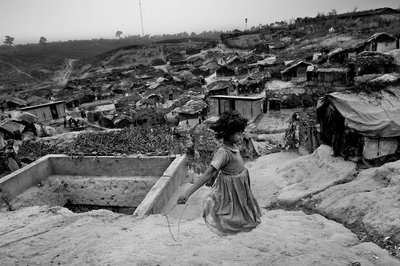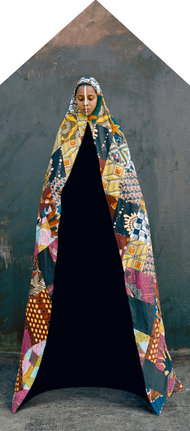Chobi Mela VII in New York Times
There are well over a hundred photo festivals around the world, and new ones pop up almost daily. Many claim to be international, usually exhibiting a few local photographers alongside some international ? read Western ? photographic luminaries.
What sets apart the Chobi Mela International Festival of Photography in Dhaka, Bangladesh, is that it is not only truly international, but is also perhaps the world?s most demographically inclusive festival. Running this year from Jan. 25 through Feb. 7, it will feature photographers from 23 countries and every continent except Antarctica. This year, separate programs, presentations and exhibits focus on photography from China, Russia, Nigeria, Latin America and the Middle East as well as Bangladesh.
The festival was started by Shahidul Alam, the founder of the Drik Picture Agency and the Pathshala South Asian Media Institute and the force behind the ascendance of Bangladeshis in the global photographic community. The festival lets fine art photographers, conceptual artists and photojournalists explore issues of social inequality, injustice and cultural and economic hegemony. This year?s theme is fragility.
?At Chobi Mela, we actively try to engage with photography that is not so well known but is from a very different perspective and challenges the predominant culture of photography,? said Mr. Alam, who is the director of Chobi Mela.
Since it started in 1999, Chobi Mela has had many noted international participants, including this year Eugene Richards, Graciela Iturbide, Walter Astrada and Anastasia Taylor-Lind. But there are many more photographers who are little known in Europe or the United States.
That combination of photographers lends the festival a syncretic touch ? sometimes exemplified in the same person. Ma?mouna Guerresi was raised a Catholic in Italy but converted to Islam after encountering an African Sufi community in Senegal. She is a sculptor, video artist and photographer who lives both in Italy and Senegal.
At Chobi Mela, Ms. Guerresi is exhibiting images (Slides 1 to 7) of mystical figures from Islamic Africa that she created by posing her multiethnic family in robes that are also sculptures she made. Only her subjects? faces, hands and sometimes their feet are revealed. She views the images as metaphysical, photographs that are not about ?people or facts but represent ?infinity and cosmic space.? ?
?Ma?mouna is looking at a religious and a cultural phenomenon in a visually arresting manner,? Mr. Alam said. ?But she is also describing it in a conceptual way as opposed to the more literal, documentary rendering we?ve seen about Sufism by and large.?
Mr. Alam also selected the documentary work of Saiful Huq Omi for this year?s festival. He is a Bangladeshi photographer (Slides 8 to 12) who has been documenting the plight of the Rohingyas, a Burmese Muslim ethnic minority. Tens of thousands of them have fled oppression, human rights violations and violence in western Myanmar and now live as refugees in Bangladesh.

Their life there is hardly better. Women living in refugee camps have been gang-raped, sometimes more than once, and they have been forced to marry local musclemen. The refugees receive little support from the government of Bangladesh and have been classified as illegal immigrants.
?In Bangladesh, the Rohingyas now survive in inhumane conditions ? 16 or more refugees live in a room that is barely more than three square meters with food and medicine scarce,? Mr. Omi wrote in his exhibition statement. ?Almost 80 percent of children and 53 percent of adults were reportedly suffering from chronic malnutrition.?
Mr. Alam said he created the Chobi Mela festival primarily so Bangladeshi photographers could be more widely exposed globally, extending to international audiences.
?I wanted to create a bridge,? he said. ?But it also gives us a chance to take stock of this remarkable transformation that is taking place within photography in Bangladesh.?
Follow @shahidul, @JamesEstrin and @nytimesphoto on Twitter. Lens is also on Facebook.
Please Retweet #photography #chobimela #drik #Bangladesh
Latest Posts
Categories
- 1971
- Afghanistan
- Arts
- Bangladesh
- Capitalism
- Caretaker government
- Censorship
- China
- Chittagong Hill Tracts
- Chobi Mela
- Chobi Mela VII
- Coal
- Colonialism
- Consortium government
- Corruption
- COVID 19
- Crossfire
- culture
- Current News Photos
- Democracy
- development
- Disappearances
- disasters
- Drik and its initiatives
- Drik DNA
- Drik's Network Partners
- Drugs
- economy
- Education
- Elections
- Energy
- environment
- exploitation
- features
- Film
- Garments
- Gas
- Gender
- Genocide
- Global Issues
- Governance
- guimet
- Health
- History
- Human rights
- Humour
- Immigration
- Imperialism
- India
- Interesting sites
- Interviews
- Interviews and Features
- Islam
- Kalpana Chakma
- Killings
- Law
- lectures
- literature
- Major Features on Bangladesh
- Majority World
- media
- Media issues
- Migration
- Military
- mining
- Mir Jafar
- Monarchy
- Music
- My Photo Essays
- Nepal
- New Age
- New Media
- News Archives
- News Photo Archives
- Nuclear
- Occupation
- Oil
- Pakistan
- Partition
- Pathshala
- People
- Personal
- Photography
- Photojournalism
- Photojournalism issues
- photojournalist
- politics
- Poverty
- RAB
- Rahnuma Ahmed
- Religion
- Resistance
- Reviews
- Science
- security
- Shahidul Alam
- Sheikh Hasina
- short stories
- Sites of Drik and Pathshala photographers
- South Asia
- Southern Exposure
- Sports
- Sri Lanka
- surveillance
- Taliban
- Technology
- Terrorism
- Transport
- UK
- Uncategorized
- USA
- Violence
- War
- war on terror
- Water
- World
Tags
1971 Art Arts Bangladesh book censorship Chobi Mela Chobi Mela VII culture Death democracy Dhaka Drik education Elections exhibition Festival garments Gaza Genocide Governance history Human rights India Israel Journalism Law literature Majority World media Military Pakistan Palestine Pathshala Photography Photojournalism politics Rahnuma Ahmed resistance Shahidul Alam USA Violence Visual Arts War War Crimes






Leave a Reply
You must be logged in to post a comment.